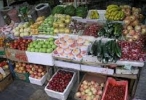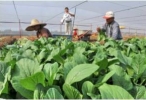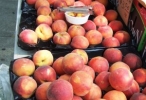VIR 2SYL
Report:Compatibility of a Disinfectant in Water Used for the Transportation of Fruits and Vegetables
1.Introduction
VirO2Syl is a disinfectant – free of chlorides – which is used for the disinfection of water in several applications. Watersorting units are used to sort fruit (pears and apples). These units consist of several sorting channels, which are filled with water in which the fruit is transported to the final packing zone. A closed water system is used, only the loss of water is restored by new water.
Since the total water volume is replaced only occasionally, the microbiological contamination can be very high and can have a negative influence on the storage time period and the end-quality of the fruit.
VirO2Syl offers the possibility to decrease the microbiological contamination significantly, when added in adequate doses to the transport water. It is an ecologically sound product and a suitable alternative for chlorinated disinfectant products.
The aim of the project is to examine the application of VirO2Syl for the disinfection of the transport water without affecting the quality of the fruit.
2.Description of the Project
A possible interaction between the ingredients of VirO2Syl and the fruit is evaluated using migration tests, during which the effect of different parameters is studied.
The following variables are selected and studied:
a.Concentration of VirO2Syl
b.Influence of the temperature
c.Influence of the contact time
d.Influence of the substrate
e.Influence of the tap water (hardness)
f.Interaction with the substrate (fruit)
3.Experiemental
3.1Migration Tests
3.1.1Concentration VirO2Syl Solutions
Concentrations of 100 mg/l and 1000 mg/l VirO2Syl solutions are evaluated. These solutions are prepared diluting the VirO2Syl solution (concentration = 351 mg Ag/l. The dilution is made in purified water and in tap water (hardness = 8.7°F).
3.1.2Migration Conditions
The migration tests are performed under standard conditions:
-A fixed ratio between the fruit surface / VirO2Syl solution; 250 ml solution in case of apples; 300 ml solution in case of pears;
-Isotherm temperatures (4°C and 22°C);
-Conditioning period (1 hour and 12 hours)
The experiments are performed in triplicate. A distinction is made between different substrates: apples and pears.
A blanc solution is used as a reference.
A difference is made between the first, second and third rinsing period.
3.1.3Evaluation of the Washing Solutions
The apples and pears are immersed completely in the VirO2Syl solution. After the conditioning period, the fruit is removed out of the solution and dripped dry (glass funnel). Afterwards, the fruit is rinsed three times. The first two times of rinsing are performed with 50 ml tap water). For the third rinsing period, 40 ml 1% HNO, solution is used.
The resulting washing solutions are analyzed on the same day by means of ICP-OES, to determine the Ag concentration, left on the substrate. The detection limits amounts to 0,1 µg Ag, calculated on the substrate.
3.2Interaction with Damaged Fruit Tests
3.2.1Penetration in the fruit
The possible migration of ingredients from the VirO2Syl solution into the substrate when it is damaged, is also evaluated. The tests are performed with a concentration of 1000 mg/l VirO2Syl solution. The dilution is made in tap water.
Two notches are made in the substrate with dimensions:
-Width: 5mm
-Length: 10mm
-Depth: 5mm
The apples and pears are immersed in the VirO2Syl solution in such a way that one notch is in contact with the solution. The other notch can be considered as a blanc. After a condition period of 1 hour at room temperature, the fruit is removed out of the solution and rinsed with tap water. Then the skin is removed around both notches.
Three pieces are successively removed around the notches of one apple and one pear: the first part is removed 2mm at the level of the notch, the second part is removed 2mm further and third part is removed 5mm further.
On the second apple one big part (9mm) is removed around the notch.
These parts are destructed in HNO, and the resulting solutions are analyzed to determine the amount of residual Ag.
4.Results
4.1Migration Tests
4.1.1The reproducibility of the method meets the requirements for the evaluation of the selected target.
4.1.2Every test is performed in triplicate. The mean Ag concentration is calculated for every rinsing period. The sum of these mean concentrations (µg Ag/substrate) together with the standard deviation is represented.
The following parameters are represented:
-The conditioning period: 1 and 12 hours;
-The temperature: 4 and 22°C;
-The mean weight of the substrate.
4.1.3100 mg/l VirO2Syl Solution
It can be stated that a negligible concentration of Ag is left on the apples and pears. During the first rinsing periods with MQ water, a residual concentration <0,1 µg Ag/piece of fruit is detected. The third rinsing period with 1% HNO, reveals a residual concentration <1 µg Ag/piece of fruit. There is no effect of the selected variables on these results: substrate (apples – pears), temperature (4 - 22°C), diluents (MQ water and tap water).
1000 m/l VirO2Syl Solution
It can be concluded that in comparison with the concentration of 100 mg/l VirO2Syl, a minor residual Ag concentration remains at the fruit. The total Ag concentration after the sequential rinsing however, is still very low. As well as for the pears as the apples, the maximum residual concentration is <3,5 µg Ag/piece of fruit.
Pears:-After a contact time of 12 hours, a higher residual Ag concentration is detected in comparison with a contact time of 1 hour. This is most distinct when MQ water is used as siluent. The increase of the residual Ag concentration after 12 hours, is particularly observed in the third washing solution.
-Using MQ water as diluents results in a higher residual Ag concentration.
The preselected temperatures (4 and 22°C) do not effect the residual concentration.
Apples:-After a contact time of 12 hours, a higher residual concentration is detected in comparison with a contact time of 1 hour (except for the parameters 22°C/MQ water). When using tap water, this increase is located in the first rinsing period.
-No unambiguous influence on the residual concentration can be determined when using different dilluents (MQ and tap water).
-The residual Ag concentration is independent of the selected temperatures.
The residual Ag concentration on both substrates (apples and pears) are within the same concentration range and cannot be differentiated.
4.2Interaction with Damaged Fruit
-No residual Ag concentration is detected in the three pieces around the notch for both substrates (<0,06 µg Ag/substrate).
-For a specific surface (9mm) around the notch a resideual concentration of 0,09 µg Ag/apple is detected.
These experiments indicate a rather limited migration of Ag into the pulp of the fruit.
5.General Conclusion
5.1Migration Tests
For a 100 mg VirO2Syl solution, it can be stated that there is no retention of the Ag on the fruit independent of temperature, dilluent, substrate or contact time.
For a 1000 mg VirO2Syl solution, a limited residual concentration is detected (3,5 µg Ag/piece of fruit). Because of the low concentrations, no negative or toxicological effects are to be expected. Moreover, these tests were performed under conditions of “worst case”. In practice, it can be expected that the contact time and the initial concentration will be lower so that the final residual content will be negligible.
Visually, no effect of discoloration on the skin of the fruit is observed.
Finally, it can be concluded that there is no influence of the temperature or diluents on the final residual concentrations.
5.2Interaction with Damaged Fruit
If a damaged piece of fruit is brought in contact with a VirO2Syl solution of 1000 mg/l, a minimal residual amount of Ag is detected on the fruit. This concentration can be considered as non-toxic.
It can be concluded that the Ag concentration is situated rather as a spot, and a negligible migration in the fruit can occur.










